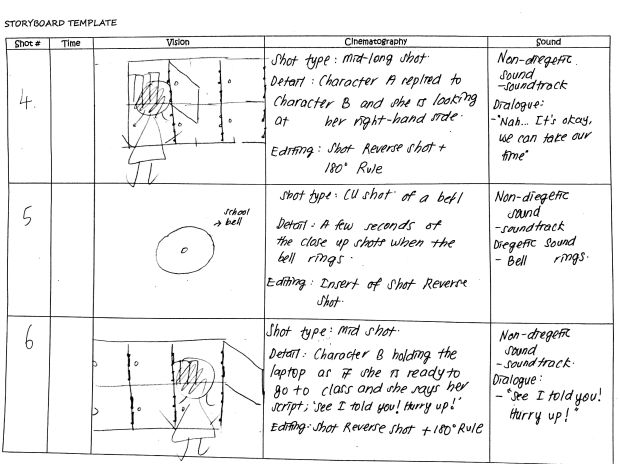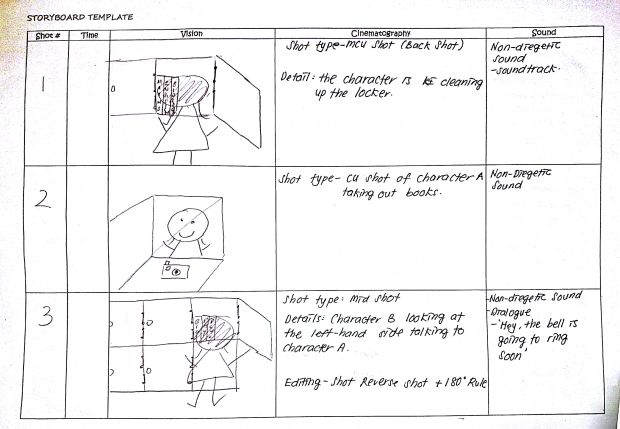This is the storyboard of my continuity editing sequence:



Reflection:
Continuity Editing is an editing style that aims to present the text in a chronological manner to emphasise the real-time movement of the narrative and to create a sense of realism for the audience by giving the impression of continuous editing.
The purpose for this preliminary task is to familiarise myself with an array of shots required in order to meet the requirements of filming a continuity sequence such as match on action, 180 degree rule and shot reverse shot. I learnt how to shoot the video using the cinematography require to produce a continuity editing sequence. I filmed using school camera which is Panasonic AG-HMC153MC.
Match On Action – This is one of the film editing techniques needed for continuity editing where the first shot of an action cuts to another shot of the action and these shots need to match in succession. Match on action tends to give the impression of continuous time when watching an edited film. This is the part where I use match on action:
I used a long shot and mid-long shot so that the audience is able to see the action within the mise-en-scene. I realised that most of the match on action editing technique uses long shots of an object then cuts to the close-up shot continuing the action from the first shot. I chose to subvert the CU because the above shots depict a two-shot moving clip.
180 Degree Rule – This film technique is a fundamental guideline where the camera position needs to be within a field of 180 degrees when the characters are having a conversation through the same left-right relationship to each other. The first character is composed frame right of the second character; the composition of the second character is always frame left of the first. Cut together on a timeline, this editing technique is used in order to avoid the audience getting confused and disorientated. The part where I use 180-degree rule is:
Shot Reverse Shot – Again this is one of the continuity techniques conventionally used when the characters are having a conversation. This film editing technique basically shows one of the character’s perspective looking at the other character. This is the part where I use an insert with the short reverse shot of the characters talking; the insert depicts a close up of the school bell when it rings.
Sequence Reflection – I purposely left the footage to be super bright i.e. high-key lighting, so that will heighten the comedic atmosphere of this sequence. This connotes that my sequence applies to the codes and conventions of the comedy genre. I made some mistakes during filming where my camera was in the wrong position. At first my camera position was here:
but then I moved and filmed from a different position:
This is because the part where the camera was inside the locker is on the right-hand side and when I filmed from outside of the locker, it should have been the opposite.
Also, I need to focus on the lighting between the two scenes. These scenes have very inconsistent lighting as if they are in totally different places, which could make the audience confused.
Overall, I learnt how the camera should have been positioned in order to apply it to the specific film editing techniques required.
Will you consider using these techniques in your coursework?
I may consider using the techniques in my trailer, especially the shot reverse shot technique since that is a convention of editing when someone is having a conversation. My coursework genre is ‘RomCom’ which signifies that I would have quite a number of scenes where the characters are having conversation.












